
Successful marketing requires a focused strategy and an outstanding team to bring it all together. However, introducing an effective marketing organization structure can take your business to the next level.
With a solid marketing structure in place, your staff knows exactly what is expected of them. With everyone clear on their jobs and their roles in the company’s success, everything operates more smoothly, and it enables your team to work in unison.
However, not all business models are suitable for all companies. If you want to choose the right marketing organization structure, you need to know which type is best for your business.
How do you choose? Let’s talk about the five most common structures, how they work, and the pros and cons of each one.
What Is a Marketing Organizational Structure?
A marketing organizational structure is the setup of a company’s marketing department. It determines the leadership chain and sets out your business’s goals. It also defines employee roles, establishes employee structure, and organizes teams.
Organizational structures in marketing come in many shapes and sizes, but they all serve the same purpose: to create a system that enables the marketing department to function effectively and achieve its goals.
As Gartner’s Marketing Organization Survey 2020 notes, marketers are continuing to strive to create “more effective and responsive organizations” while minimizing disruption.
According to their research, 27 percent of marketers use functional marketing organization structures in their business.

Why a Marketing Organizational Structure Is Important
Setting up a structure benefits your company in multiple ways, empowering employers, allowing better focus, and enabling agility. Let’s look at this in more detail.
Improves Agility
Today’s businesses need to be agile. Agility is essential in fast-changing sectors, allowing your team to enhance efficiency, prioritize workloads, create relevant products, and allocate budgets more effectively. It also makes it easier to shift when technology, trends, or Google’s Algorithms change.
Agile marketing is increasing in areas like content creation and creative services, with 77 percent of businesses taking this approach.
Empowers Your Employees
If you want your business to succeed, you need the best people for the job. A functional marketing organization structure groups your team based on skills, ensuring you have the right person for each job and they have the support they need.
When employees are in positions that fit their skills and the support they need, they are empowered to succeed—which improves loyalty and your bottom line.
Improve Employee Focus
When employees have clear goals, it’s easier for them to concentrate on their tasks. When every employee on the marketing team is working with the same focus, it streamlines the process and enables collaboration.
Additionally, focus keeps team members engaged. This is crucial because, according to Gallup, engagement increases productivity by 18 percent. Further, it increases profitability by 23 percent, while decreasing absenteeism by 81 percent.
5 Types of Marketing Organizational Structures
There are several types of marketing organizational structures. Each model has its own advantages and disadvantages, which we detail in this section. Keep in mind what works well for your business may not be suitable for someone else.
A company’s structure depends on its size, products, customers, and type. Below, we’ll cover the most common systems and who should consider using them.
1. Functional Marketing Organizational Structure
A functional marketing organizational structure describes a company’s design and is built around the marketing functions it has to perform. As detailed in the intro, research by Gartner shows 27 percent of marketers use this model.
The functional structure allows for clear communication and cooperation between different departments. It also makes it easy to identify and assign specific tasks to individual employees.
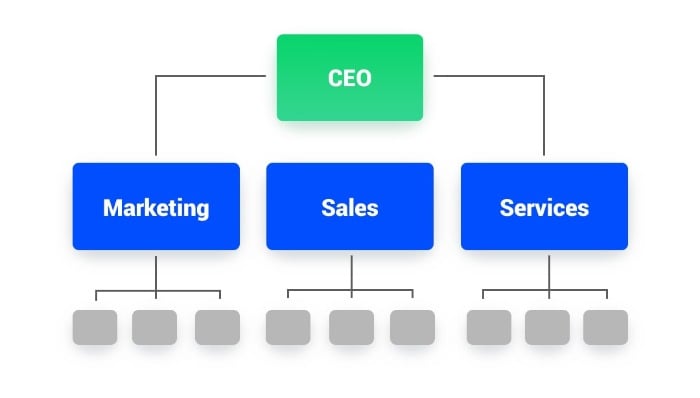
This type of structure allows for greater specialization and expertise within the marketing function, leading to improved efficiency and effectiveness in marketing operations.
Amazon uses this structure for its e-commerce business because it’s well-suited to the sector. Additionally, the functional marketing organization structure is favored by larger organizations and is ideal for companies with a stable environment.
Despite the positives, this structure can lead to communication breakdowns, decreased creativity, and inflexibility. Additionally, it may be difficult to move people around within a functional frame, potentially impacting the company’s ability to respond quickly to market changes.
Finally, functional structures can be difficult to manage when a business grows too large.
2. Segmented Marketing Organizational Structure
Segmented marketing organizational structures allow firms to tailor their marketing efforts to specific customer segments. For each segment of customers, a different team is responsible for understanding their needs and creating tailored marketing programs.
The structure usually works well for companies with a large customer base and a complex sales process. Businesses can ensure customers are constantly engaged, and it allows the streamlining of communication between different departments.
Additionally, organizations using this model can decide how best to segment depending on their aims and the resulting customer insights.
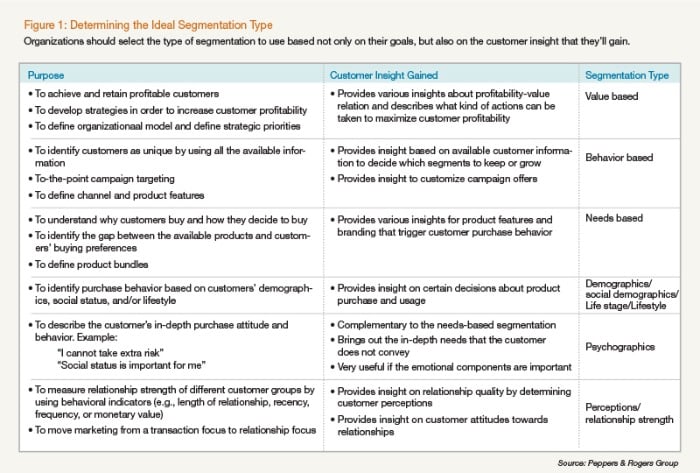
Advantages of this model include:
- Improved customer engagement due to increased focus.
- Improved communication and collaboration due to smaller, more focused teams.
- Increased efficiency due to specialization.
- The ability to spot new trends faster.
- Customer trust through relationship building.
However, this structure can also be costly because it requires multiple teams with different skills and knowledge.
3. Product Marketing Organizational Structure
Product marketing teams have a multitude of tasks, including target audience research, content marketing, and analytics. Then there are co-branding partnerships to consider, with research showing 71 percent of consumers enjoy multiple brands working together to make a unique product.
With so much going on, what’s the best way to coordinate? By introducing a product marketing organization structure.
In this model, each group has its team of marketers responsible for developing and executing the marketing strategy for their specific product line. A product marketing organizational structure is the preferred model for businesses with different lines of products/services and looks like this:
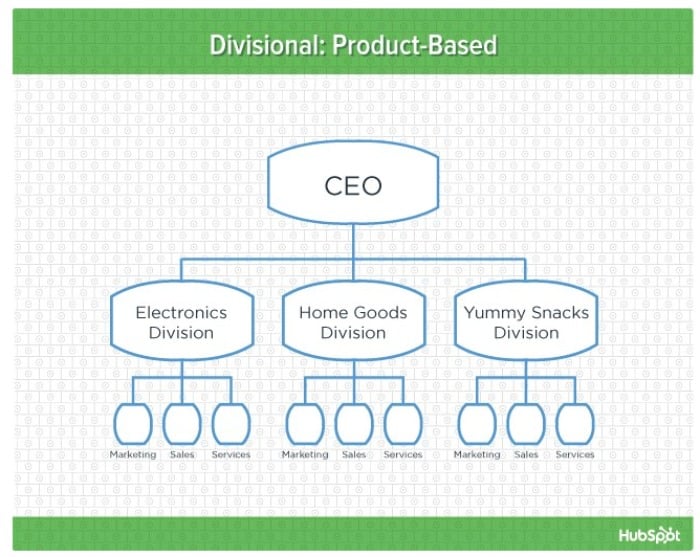
This model allows organizations to respond to changing trends and meet customer needs while concentrating on targeted market sectors.
However, it can be difficult to track and measure the effectiveness of the marketing activities due to a lack of central control and duplicate roles in different divisions. To work around this challenge, businesses may consider grouping similar products together.
4. Digital Marketing Organizational Structure
A digital marketing organizational structure is essential for any company looking to create an online presence. If your business has a dedicated team to handle all digital marketing tasks, you can make and implement a cohesive strategy to reach your target audience.
The structure of a digital marketing department varies by company size but often includes a mix of people with various backgrounds and skillsets.
With a digital marketing organization structure, the company can have specialized teams that focus on different aspects of digital marketing, such as search engine optimization (SEO), paid search engine advertising (PPC), graphic design, and content marketing.
This specialization allows each team to become an expert in their area of focus, which leads to better results for the company.
Depending on which model you use, your structure might look like this:
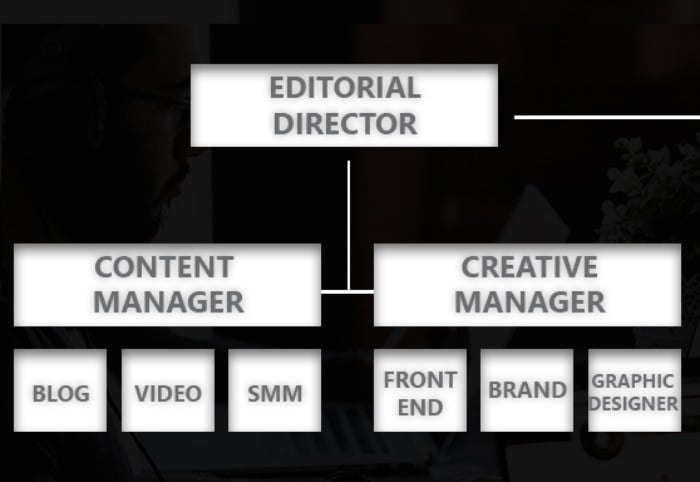
You might also choose to have different organizations for paid versus organic, social versus content, and so forth.
5. Hybrid Marketing Organizational Structure
In today’s business world, companies need to adapt to the ever-changing market. One way to do this is through a hybrid or matrix marketing organizational structure. This structure allows companies to have the best of both worlds by combining the advantages of both functional and divisional systems.
Both of these structures have their advantages. For instance, a functional structure works on a centralized basis, with each department reporting to a single leader. This allows for better communication and coordination between departments.
By contrast, a divisional structure is centralized, with each department having its own head and reports to a different leader. This allows for more local decision-making but can lead to duplication of efforts and coordination problems between departments.
In practice, your hybrid/matrix marketing organizational structure might look something like this:
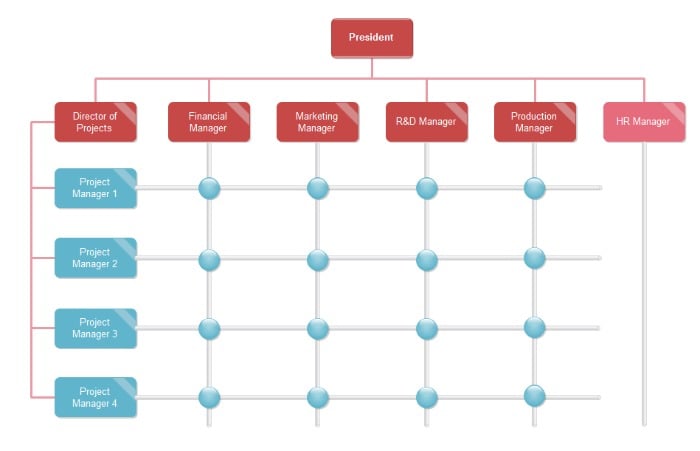
The flexibility of the hybrid model means it’s enormously popular among businesses, with 72 percent of employees working in matrixed teams.
A big advantage of a hybrid marketing organization is they tend to be more responsive to changes in the market. Because it is flexible, it can quickly adapt to new conditions.
However, a hybrid structure can lead to conflict between departments or divisions, and it’s sometimes hard for departments to coordinate. Gallup’s research also uncovered a lot of overwhelm with the hybrid model, with 45 percent of employees saying they spend most of their day responding to requests from coworkers.
Companies often use the hybrid model in dynamic environments which move from project to project.
More Tips to Pick an Organizational Structure
The market organizational structures listed above are among the most popular, but there are more you could choose from.
For instance, a linear organization structure is a management style where all employees and managers report to one boss.

This type of organization is common in small businesses and marketing organizations. The linear organization structure is easy to understand and can be effective when the company is small, and everyone reports to the same person.
In a marketing firm, you can use the linear form to control the flow of information from the top down. However, this can also be limiting because it does not allow for horizontal communication among employees.
Finally, projectized organization structures are organizational structures in which specific, temporary projects are given to their departments that report directly to top management. In businesses with high fluctuation in workloads, this type of structure makes it possible to quickly set up and disband project-specific teams as needed.
A typical projectized organizational structure would look something like this:

When choosing an organizational structure, think about both your current needs and your future needs. If you plan to launch several products in the next year, for example, it makes sense to create a product-based marketing structure from the start.
Marketing Organization Structures Frequently Asked Questions
What is the best marketing organizational structure for small businesses?
Each business works differently, meaning which system works well for one may not work for another. The linear structure, which has one leader, is the most common. You could choose from several types, including functional, matrix, or divisional.
What is the best marketing organizational structure for B2B businesses?
To keep things simple, consulting firm the Pedowitz Group suggests a basic structure for a B2B marketing organization structure to focus on tasks like content and digital services, digital demand generation, and reporting to a CMO. There is no “one size fits all” structure for a business: you need to begin by looking at your business’s overall aims and current strategy. To guide you, the Edward Lowe Foundation has some great tips.
What is the simplest marketing organizational structure?
The linear structure is the most basic model and the functional structure is the most common and also easy to implement.
How long does it take to set up a marketing organizational structure?
It varies depending on the size of your business, the type of structure you go with, your goals, and your current strategy. It can take weeks or months to get it right, and then you need to review your structure regularly to make sure it works for your goals.
Should I consider freelancers and contractors in my marketing organizational structure?
Yes, consider all options when structuring your team. This includes both freelancers and contractors. Freelancers can be an excellent option for short-term projects or for filling gaps in your team’s skill set. Contractors can be a good option for long-term projects.
Conclusion: Marketing Organization Structures That Fuel Growth
The structure of an organization’s marketing department can significantly impact its overall performance.
The best structure for your business will depend on the products or services you offer, the size of your company, and your geographical location.
Companies should carefully evaluate their options and select the format most likely to lead to success.
Popular choices include the foundational structure, product-based, or a divisional model. Alternatively, you might want to adopt a hybrid model to cater to today’s hybrid consumers.
Do you use a marketing organization structure? Which model works best for you?

See How My Agency Can Drive Massive Amounts of Traffic to Your Website
- SEO – unlock massive amounts of SEO traffic. See real results.
- Content Marketing – our team creates epic content that will get shared, get links, and attract traffic.
- Paid Media – effective paid strategies with clear ROI.